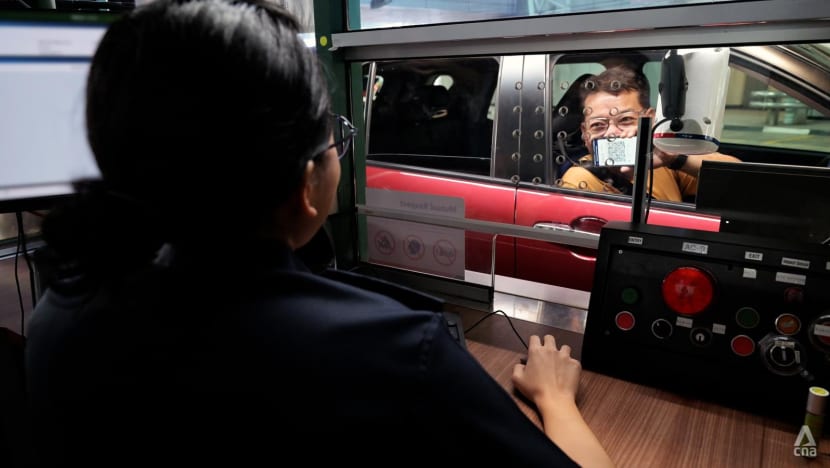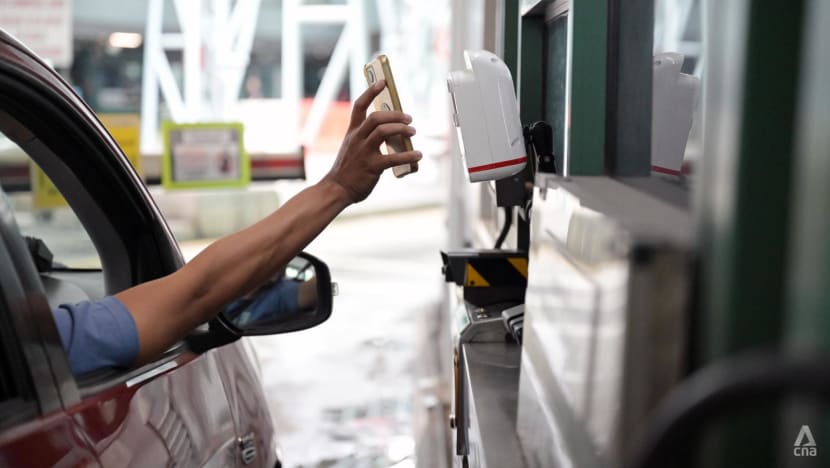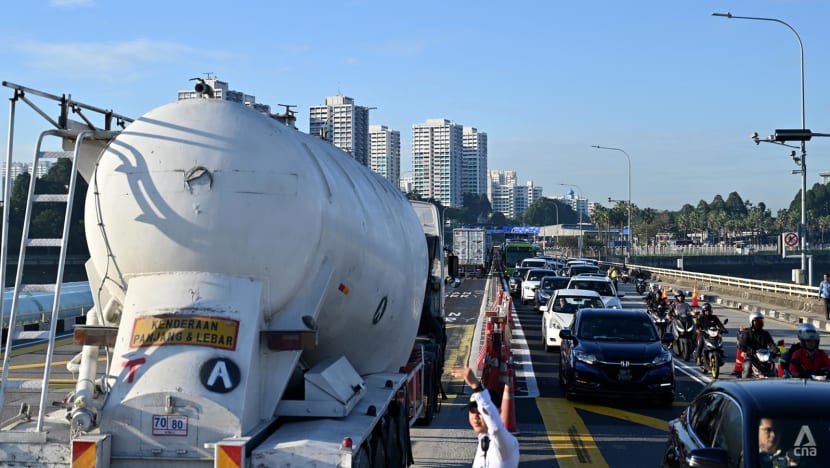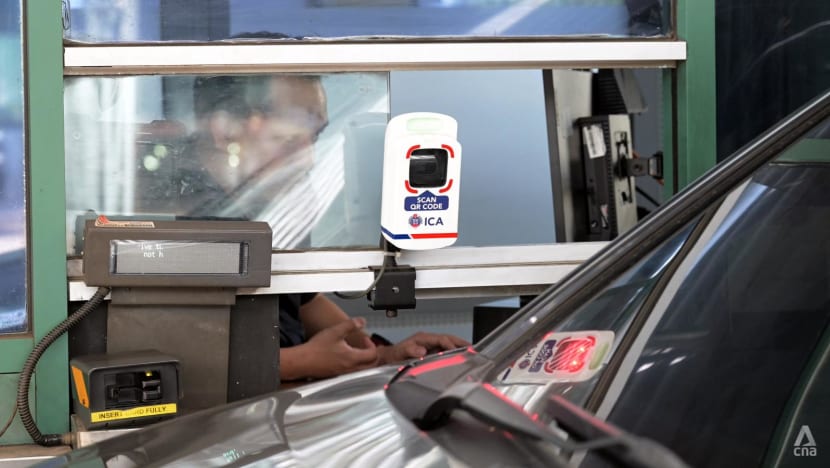'Like an F1 pit stop': QR code system has made immigration clearance more efficient, ICA officers say
Immigration and Checkpoints Authority officers were sent for training sessions from December last year before the trial for the QR code system began, where they gained an understanding of how the system would help them in their roles.

A driver showing an ICA officer his QR code at Woodlands Checkpoint on Jul 29, 2024. (Photo: CNA/Try Sutrisno Foo)

This audio is generated by an AI tool.
SINGAPORE: A car pulls up next to Immigration and Checkpoints Authority (ICA) officer Fatin Amirah Abdullah’s booth at Woodlands Checkpoint.
A flash of his phone screen, a quick check of his face and identity by Sergeant Fatin, and the lone driver is off, crossing the border into Singapore.
“Just like an F1 pit stop,” quipped the assessment and investigation officer.
Sgt Fatin is among the hundreds of ICA officers whose workflow has been made more efficient by the launch of the QR code clearance system for cars in March this year.
“When I first started, we all used to scan the passport physically ... So when there's a car with 10 people, we have to scan them each one by one,” said Sgt Fatin, who has been with the agency for just over a year.
The manual scanning was more tedious and took longer, she said, and the new QR code concept has cut down the clearance timing per car by “a lot”.
For instance, to clear a car of four travellers, an officer had to click about 20 times on the immigration clearance system on the computer. That has now been reduced to four clicks.
“So there's about an 80 per cent reduction, and this reduction in the clicking time also translates to faster clearance for the car travellers,” said Superintendent Peck Yong Tat, senior assistant director for cargo and conveyance in the ICA’s future operations and transformation branch.
ADOPTING A NEW SYSTEM
The QR code system was intended to operate alongside, and not replace, the option for travellers to present their physical passport for immigration clearance, said Supt Peck.
“At first, definitely we were all used to scanning passports one by one, and a bit sceptical about the security aspect of the system,” said Sgt Fatin.
To understand how the new system would work, all officers were sent for training starting December last year ahead of the launch.
“It was actually easy to learn and we got used to it after a few days, so it was very fast for us to know the system well,” said Sgt Fatin.
Despite the quicker clearance process, officers like Sgt Fatin still rely on traditional methods for security checks, such as calling out each passenger’s name and getting them to respond, and visually confirming that the passenger’s face matches the passport photo that pops up on their screen.
Taking the concept from trial to actual implementation took about three months, said Supt Peck.

STARTED FROM PANDEMIC
The concept for the new clearance system first emerged during the COVID-19 pandemic, when the use of QR codes was prevalent with the check-in system SafeEntry and the increased use of digital payments, explained Supt Peck.
“It was opportune for us to adopt a system that was widely used and familiar amongst many as a means of immigration clearance.”
Much effort went into creating a system that enhanced the clearance process for travellers while also meeting ICA’s own operational and data security requirements.
“Initially, we were worried that car travellers didn't want to use QR codes,” said Supt Peck.
His team of 11 hence made a conscious effort to gather as much feedback during the design process, and held weekly interviews with members of the public and other ICA officers.
They also studied other existing applications, such as national digital identity system Singpass.
“In March 2024 when we rolled out the QR code system, we had almost half of the car travellers using it, and now we have around 64 per cent,” he said, adding that ICA wants to boost the figure even more.
“The QR code take-up rate really helps everyone if it is high. That's why when people say it doesn't make a difference to them if they just use their passports, I will say that if you can save five seconds and there are 100 cars queuing in front of you or behind you, it can really make a difference.”
CHALLENGES ALONG THE WAY
Of course, creating a new immigration clearance system came with its own difficulties.
“We had some hiccups along the way during the early stages like the testing phase, where the system did not perform as we designed and intended. Thus we had to work closely with our vendors to troubleshoot the issues,” said Supt Peck.
One issue for instance was to improve the loading speed of the QR codes.
The team took the hurdles in their stride, viewing them instead as opportunities to make the clearance process for travellers even more smooth and fuss-free, he said.
When the system was rolled out, many travellers were keen to use the QR codes but did not know how to, said Sgt Fatin.
She took the time to help them run through the registration process, which took just a few minutes. “After they register their information, they immediately use the QR code and they find it very fast.”
She also handed out pamphlets to passengers unaware of the new clearance system.
“With the congestion at our checkpoints, this is definitely the better option for them to use, because some of them can be in a rush,” she said.
Overall traveller volume at Singapore’s land checkpoints has exceeded pre-COVID levels and is expected to rise further.

A NEW CONCEPT IN SINGAPORE
QR code clearance for cars started on Mar 19 this year, before being extended to buses on Apr 15. This only applies to bus drivers, and passengers still have to alight and physically scan their passports and clear immigration, before boarding the bus again.
The system will be progressively extended to other zones, such as motorcycles and lorries, by the end of this year, said Supt Peck.
Cars were selected for the first use of the new QR code clearance system due to the heavy reliance on manpower when it came to clearing cars.
Clearance for motorcycles has been automated since 2017, while more automated lanes for buses have been added since 2020, with automated immigration clearance the default at passenger halls today.

“At our cargo zones, we have also introduced the paperless clearance initiative which removes the need for the driver to provide hardcopy permits, reducing the clearance time by more than two minutes per vehicle,” said Supt Peck.
In contrast, the clearance process for cars remained largely manual, with an officer having to be stationed at every lane.
The car zones are also where multiple travellers clear immigration at the same time, compared to motorcycles where a QR code would have only up to two travellers, said Supt Peck.
“We wanted to start deploying the QR code clearance at a zone where we would be able to observe the most gains in terms of reducing the waiting time.”
Finding a way to improve the clearance efficiency for cars hence became a priority, said Supt Peck, amid the reality of manpower constraints and increasing traveller volume.
The QR code clearance is also a stepping stone to the introduction of the Automated Passenger Clearance System lanes at Tuas Checkpoint from 2026, and at the redeveloped Woodlands Checkpoint from 2028.
















